Asparagus is one of my very favorite spring vegetables. I love when I start seeing them at the farmers market, as that’s a sure sign that warm weather is near! Plus it’s just a tasty vegetable that can make any meal feel fancy. Making fermented asparagus with garlic is one of the best ways to prepare them, in my opinion. This was actually one of the very first vegetable ferments that I ever made, and I think it got me hooked on fermenting!
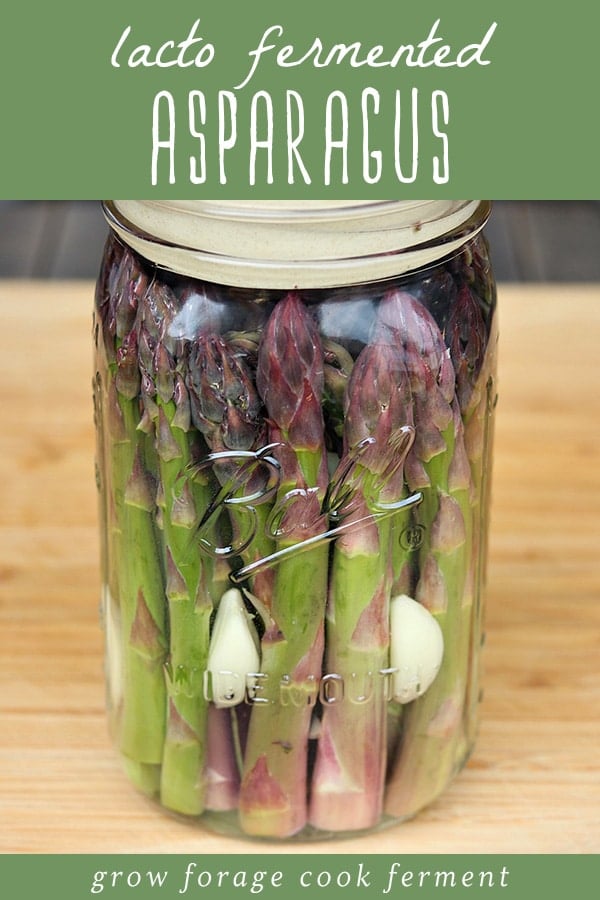
Want to save this post for later?
Fermenting Asparagus
I don’t know about you, but I absolutely love asparagus! I didn’t grow this beautiful bunch of purple tipped spears (I wish!), I got it at our local farmers market, and it was practically begging to be made into fermented asparagus!
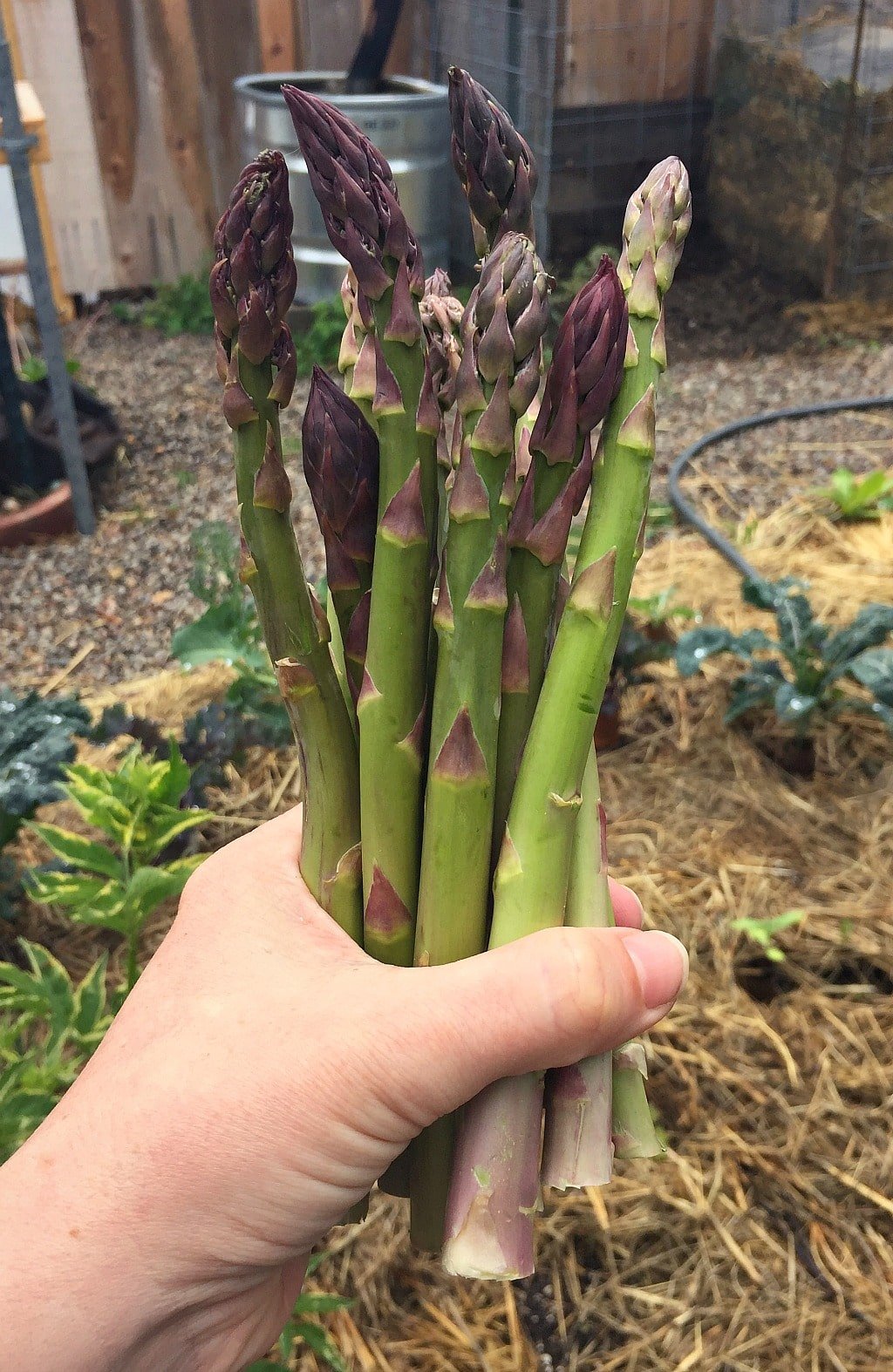
Fermented asparagus is actually one of the easier vegetable ferments to make, as there is very little prep work involved.
Asparagus fit easily into a quart sized mason jar, all you need to do is trim off the woody ends first.

Get more recipes for canning, fermenting, quick pickling, dehydrating, and freezing so that you can enjoy your summer produce year-round in my ebook Preserving the Garden Harvest!
Fermented Asparagus with Garlic Recipe
Fill a quart jar with the trimmed asparagus, then push the garlic cloves into the jar.
Mix the water and salt to make a brine, and pour over the asparagus, making sure to cover all of the veggies. You may need to make a little more brine at a ratio of 3/4 Tbsp salt to 1 cup water in order to fill the jar.
Weigh the asparagus down with some kind of weight so that they stay under the brine.

Cover the jar with a clean towel and secure with a rubber band (you can alternatively use an airlock system if you have one, but it’s not necessary).
Set in a cool and dark place for 1-2 weeks to ferment. Taste the veggies, and when they are to your liking they are done! Cover with a lid and store in the refrigerator.
Once the asparagus is done fermenting, it will lose most of its vibrant color. That’s ok, because it makes up for it in awesome flavor!
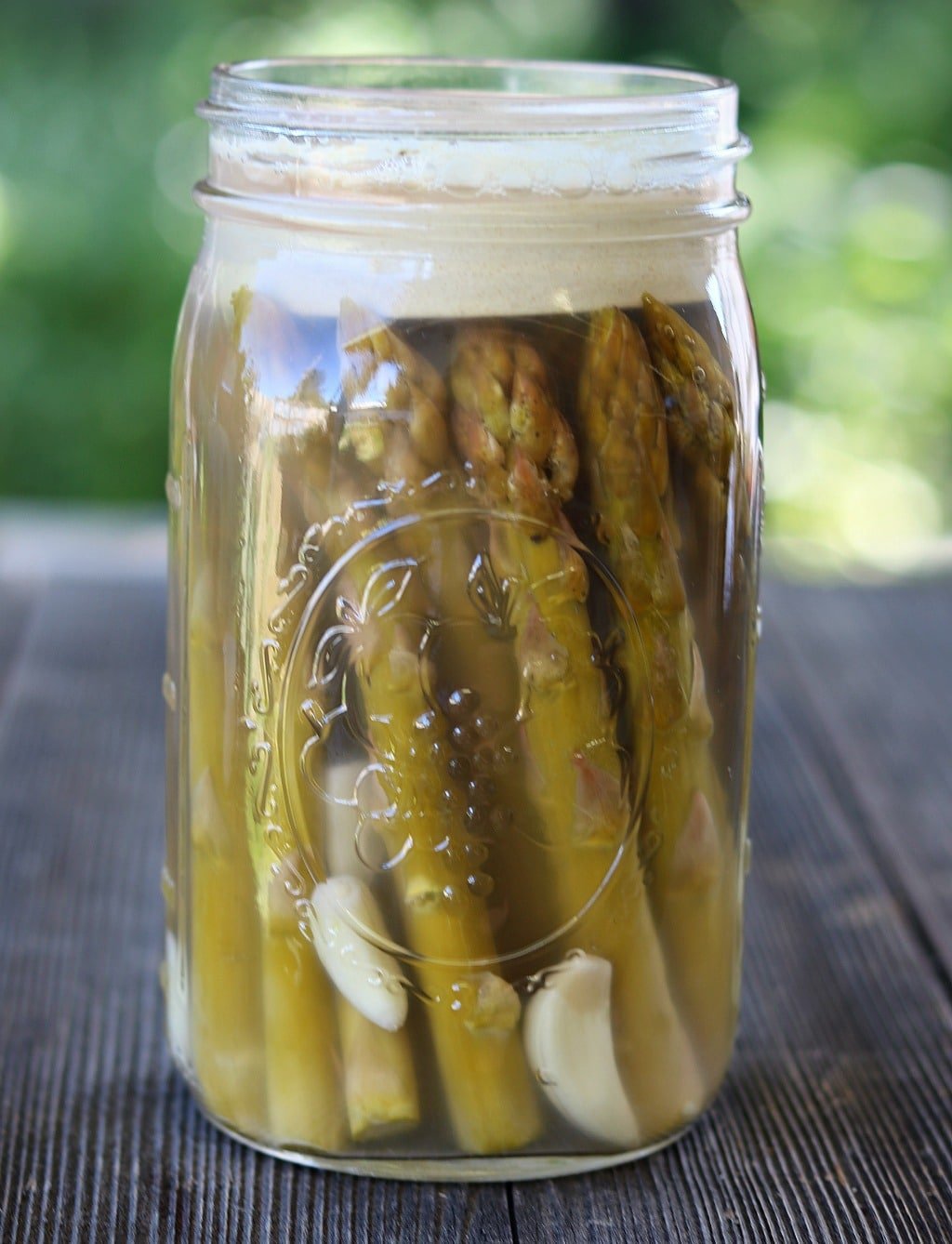
The surface of the brine may form a white film called kahm yeast, which is harmless. As long as there isn’t any black or green fuzzy mold, then you’re good to go!
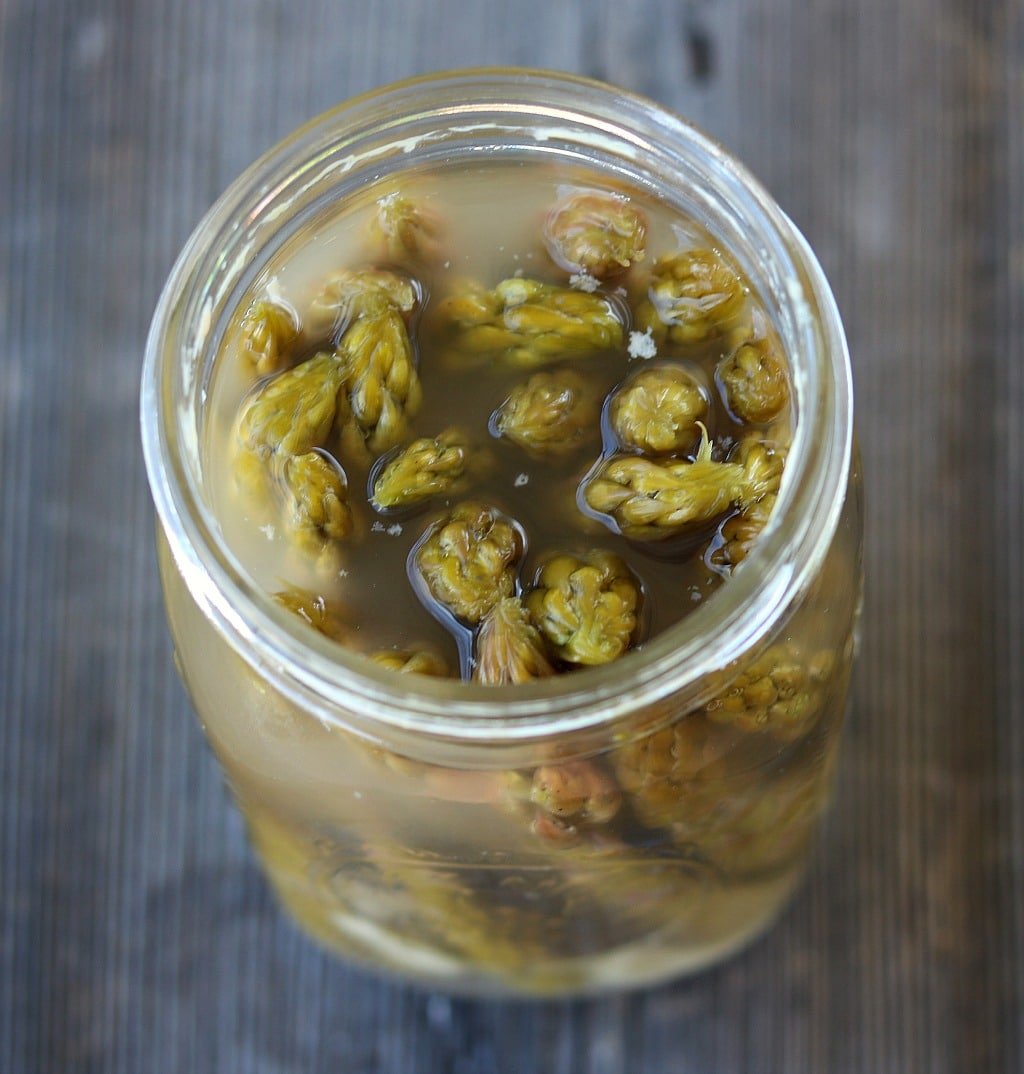
This fermented asparagus with garlic is so good! It’s perfect on an appetizer platter paired with cheese, olives, and salami.
Or you can just eat it all by itself (that’s what I usually do). Don’t forget the wine!
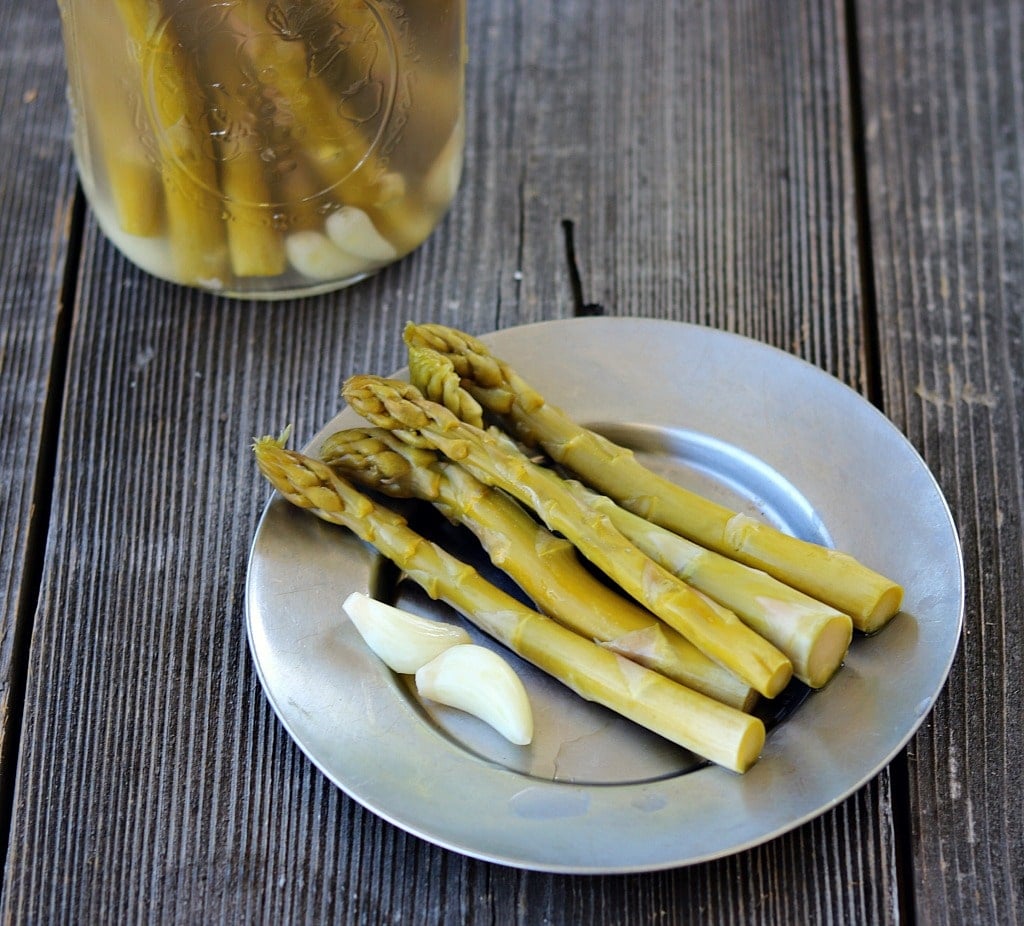
Fermented Vegetables
Fermenting vegetables is one awesome way to put up your spring and summer produce. Here are some of my favorite fermenting recipes:
- Fermented Cherry Tomatoes
- Sauerkraut
- Fermented Green Tomatoes
- Fermented Cucumber Pickles
- Lacto-Fermented Dilly Beans
- Fermented Garlic
I still think this fermented asparagus with garlic is my favorite! What is your favorite vegetable to ferment?
Fermented Asparagus with Garlic
Ingredients
- 1 pound asparagus spears
- 6-10 cloves garlic
- 1 1/2 Tbsp kosher, pickling, or sea salt not iodized
- 2 cups filtered water
Instructions
- Trim the woody ends off the asparagus so that they fit into a quart sized mason jar.
- Fill the jar with the asparagus, then push the garlic cloves into the jar.
- Mix the water and salt to make a brine, and pour over the asparagus, making sure to cover all of the veggies. You may need to make a little more brine at a ratio of 3/4 Tbsp salt to 1 cup water in order to fill the jar.
- Weigh the asparagus down with some kind of weight so that they stay under the brine.
- Cover the jar with a clean towel and secure with a rubber band (you can alternatively use an airlock system if you have one, but it's not necessary).
- Set in a cool and dark place for 1-2 weeks to ferment. Taste the veggies, and when they are to your liking they are done!
- Cover with a lid and store in the refrigerator.

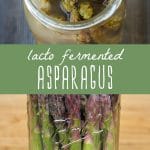
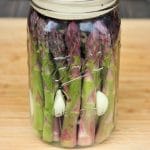

By organic bay or Laurel leaves in the jar ( maintains crispness) , and covering the top with raw organic cabbage leaves helps eliminates kahm yeast problem. When kahm yeast develops it is an indication the ratio in the jar is incorrect. Kahm yeast is easily removed by tossing the cabbage leaves and replacing with fresh organic cabbage leaves. In a decade of fermentation, following the simple steps, I rarely see yeast development in my jars.
I recently tried this and the asparagus turned out perfectly crisp and with a nice fermented flavor. I did add about a teaspoon of brine from some raw sauerkraut to help get it started. But I found the end product to be much too salty! I used Redmond Real salt. Its a pretty fine grind so I’m wondering if the ratios are a bit off because of this. So my plan is to try again and reduce the salt by at least half, but I’m wondering if I do that will the texture suffer? Thanks!!
When u ferment u add 2-3% salt as in 20 to 30 grams pr 1000 grams of water i usually do 25 :)
I just picked up our first CSA box today. It has 10 pounds of asparagus in it. I’m really looking forward to trying the fermented asparagus as a way to preserve some of these beautiful vegetables.
Tried this recipe and let it ferment for four weeks. It had a little bit of dark mold on top when I opened it. I skimmed it off no problem. The ferment smells salty of course, so no bad odors. I put it in the fridge. This is my first ferment—was the mold a “bad” mold? The water itself is a little cloudy.
Hi Brian. It’s hard for me to say without seeing it, but as long as the ferment still smells good, I think it’s fine. Cloudy brine is totally normal and a good indicator that your foodstuff successfully fermented!
Thanks. It is in the fridge now.
I followed the recipe exactly. 9 days of bubbling away and it was fermented perfectly.
1- 1/2T in 1 qt is too much pickle salt for me. Next time I’ll try 1T.
Glad you had success with this recipe, Steve!
I have recently learned fermenting using 1 tbs per C of water. Is there some reason why you use 3/4 T per cup? Thank you for a great website.
Do you need to sterilize your quart jars?
Yes, it’s a good idea to sterilize them first.
Is this brine being boiled before poured in? Also is the asparagus supposed to be blanched first? I am used to pickling but never fermenting. So this recipe is unusual for me. Thanks!
Hi, Natalie. No to both of your questions. Heat destroys the lactobacillus bacteria that are needed for fermentation occurs.
Fermentation and acidification is something great.
We have tried to ferment asparagus a few times and it always ends up smelling like a dead animal so we just do the vinegar method.
I agree. Just tried this recipe 11 days in and the smell is horrid. Not sure if it’s the asparagus or the garlic, I have not fermented either before this.
I tried a piece today and it was not for me. It was much milder but still tasted like it smelled. I think I’d rather have it fresh.
Hi Colleen,I would love to put up some pickled asparagus & garlic !! Can this be done with pickling spices and vinegar/water/salt and sealed in Mason jars for long term storage in the spring cellar like dill pickles ???
Hi Jay! Since pickling isn’t the same as fermenting, you’d need a recipe for pickling and canning asparagus. My friend Ashley over at Practical Self Reliance has a recipe for canning asparagus. I hope that helps!
Silly me !! I knew that….I guess I got lost !! After fermenting, how can one store for long term,like in a root cellar ? Would you put the fermented veggies in a mason jar in a canning bath ?? How long will they be good?? Thanks,you always have the best stuff !!!
Canning lacto fermented foods would likely kill the good bacteria that they’ve cultivated. The only way to store them for the long-term is by refrigerating. Refrigerated, they can last several months.
what do you cover jar with? you don’t use the lid to mason jar? just a cloth
I use the mason lids and rings , just do them finger tight and the gas can still escape without letting air in , I have been using this method for years and it works perfect , just make sure they’re snug bit not too tight.
I heard of doing this adding a little whey and only leaving out for a couple days. How is it different? Will it taste different? Thanks!
What kind of things do you use to weigh the asparagus down in brine?
https://amzn.to/2IvoHAt
I grow asparagus for market. About 120 lbs / yr.
Fermented some last spring.
Really good. Nice to have thru winter.
How long will fermented veggies usually stay good?
I love the idea of adding whole garlic cloves into the fermenting process with the asparagus. I have heard of fermented asparagus before but people have usually just added peppercorns and herbs and such. Adding whole cloves of garlic will surely add an intense flavor when you go to eat the finished product! I’m excited to try this recipe, thank you for sharing!!
I was cursing on the computer when I found your web site. No real interest until I started to read your emails and now I’m addicted. What great information and easy to do directions for things. It is my 101 lessons to a life I always wanted to try. Thank you for opening the door and I do share it with older family members like myself who never had farming/gardening in our lives.
Never heard of fermented asparagus! My 7-year old and I love asparagus, and I bet she will love this too. Can’t wait to give it a try. One more reason to get my asparagus patch started!